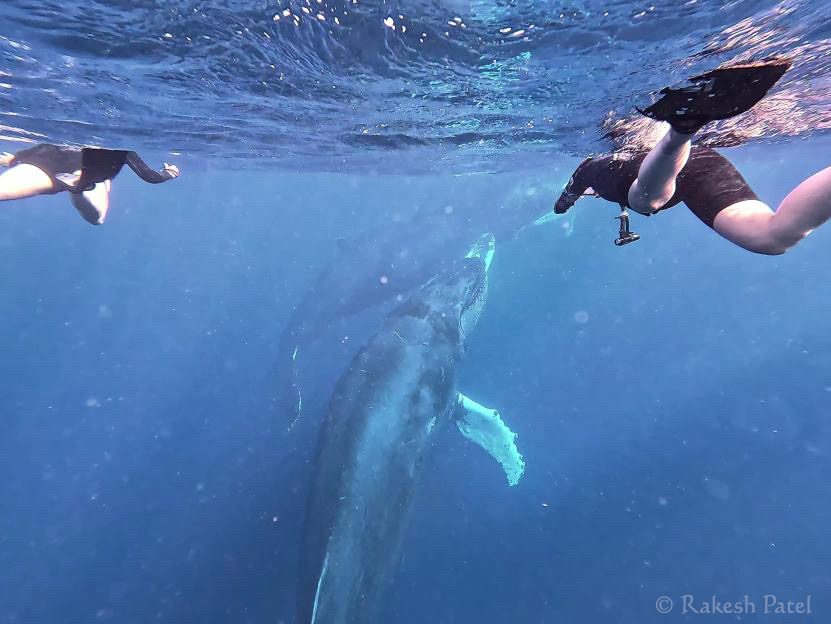February 4 – February 11, 2023
Week Three of our 32nd Season
This year Aquatic Adventures embarks on its 32nd season of providing our guests the unique opportunity to encounter the North Atlantic humpback whales on their breeding and calving grounds, the Silver Bank. As the season unfolds, we’ll highlight some of the various encounters and experiences of our guests each week. We hope you enjoy following along!
The Turks & Caicos Explorer II bounded across the sea towards the Silver Bank late Saturday night with the soon to be full moon lighting our way. The forecast suggested that the transit was going to be a little rough so guests were encouraged to take some of the seasickness medication they brought with them before they went to sleep. Better safe than sorry! Most got a very good rest over the transit as the ride out was not as tumultuous as we had predicted. Later that first afternoon within minutes of entering the water, a mother and calf gave us a quick glimpse of them in their undersea home. The pair did not stay around very long but for an encounter to happen in less than five minutes of being out on the tenders was a great start to the week. We continued to see lots of whales that afternoon but most were not settled; moving constantly, traveling around the bank, making it difficult for us to get into the water with them. But when the in-water encounters are limited, the surface activity is out of this world. All around, whales were fin slapping, lob tailing and breaching! The Aquatic Adventures team has seen this type of behavior before, usually before a full moon, which was due to rise the next evening.


Our second day of the week came with an abundance of encounters. Our first encounter was of a very friendly and relaxed mother and calf. As soon as we entered the water, the scout recognized them from the previous week; this was the mother and calf that was so comfortable with us that the calf spent multiple breathing cycles at the surface, playing and investigating the snorkelers in the water while mom stayed resting below. Just before lunch we encountered friendly sleepers and rowdy groups. There was too much action on the Silver Bank that we couldn’t pass up, so all agreeing to cut lunch short, we spent more time out with the whales. A perfect introduction to the Silver Bank! Our third day we were surrounded by mothers and calves. At one point while heading towards the protection of the coral heads, five pairs of mothers and calves were spotted within six boat lengths of our tender. Although having that many mothers and calves in the area usually leads to them not settling long enough for us to enter the water with them, this is a great sign! From our 2008 season of tagging with NOAA, we discovered that many mother and calves spend most of their time crisscrossing the same area, exercising their calves, making them strong for the journey home. It’s likely we will continue to see these whales throughout the rest of the season.

The highlight of our week, however, came on the fourth day of being out on the tenders. Around ten in the morning, one of the tenders came across a resting pair of whales in the shallows of the coral heads. Maybe fifty feet below, the whales rested while we floated passively above them. We can assume that the pair is likely a female with male escort. One of the ways to determine this is by looking at the tubercles on the rostrum. If they are scarred or raw from fighting with other whales, this is likely the male of the two.


There is truly only one way to know for sure the sex of these two beautiful mammals, and even though we can assume which one is the male by behavior and scarring, it became abundantly clear when the male came up for a close up with his genitals fully erect, giving the guests quite the shock. Laughter filled the air as the guests were not expecting to have such an “intimate” encounter. Typically in a sleeping pair, the female will stay resting for twenty minutes or so while the male comes up every ten to fifteen minutes to do a perimeter check. What made this so special was the male would come to do his check and come straight up to the guests, hovering sometimes twenty feet away before circling back down to the female. Even more special, when the female finally came up for a breath she would dance around the male, then come very close to the guests, sometimes coming up right in front and then diving directly under them, only to pop up on the other side. The pair continued with this behavior until four in the afternoon when they finally decided to move on, giving us many opportunities for some fantastic underwater photography. What an adventure!


The Aquatic Adventures team hopes that you are as inspired as we are to help sustain the humpback whale population. Through our partnership with the Center for Coastal Studies, we are helping to gain critical information on these charismatic creatures, and to seek ways to protect and preserve them. To find out more about this effort, join their mailing list or to make a donation, large or small, please visit: www.coastalstudies.org/aquaticadventures
We are proud to support SeaLegacy in their efforts to create powerful media to change the narrative around our world’s oceans. Their mission is to inspire the global community to protect our oceans. To learn more about SeaLegacy and help with this important mission, please visit: https://www.sealegacy.org
Thanks to all who have generously donated!
Learn more about Aquatic Adventures here.
Written by: Aquatic Adventures team member Gillian Morin
Edited by: Aquatic Adventures team member Heather Reser
Images: Hart Kerbel, Kevin Foster, Kara Bassignani and Rakesh Patel

